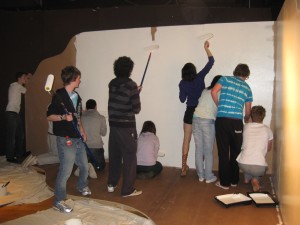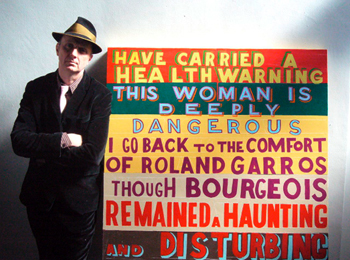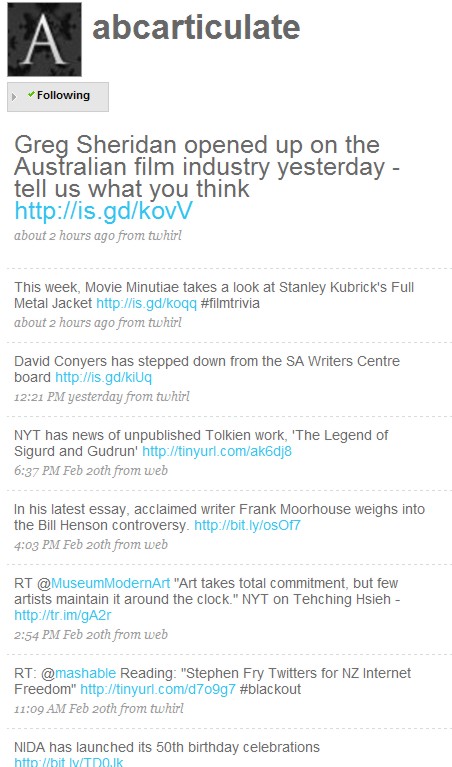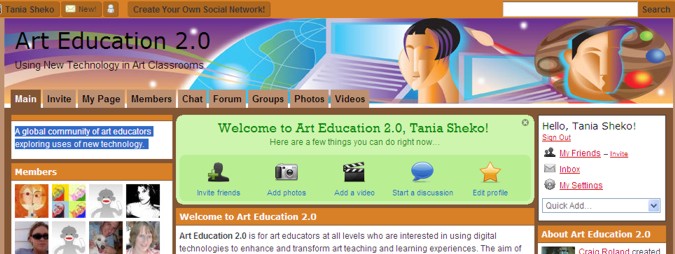Last Saturday my sister (art teacher) and I finally saw the exhibition of work which was the culmination of The Indoor Laneway project. My last post explains the project.
The exhibition space is quite large and the ideas behind the exhibit well thought out. The adolescent bedroom and laneway leading to the main screen showcasing students’ work is effective. We sat on the chairs provided (I felt a little like Papa Bear on Baby Bear’s chair) and enjoyed the mix of styles and perspectives.
As we were going out, I said to my sister, ‘It’s more than it looks’.
That’s not to denegrate it in any way. I thought the exhibition looked professional, and considering the short six-week time period for the whole thing to come together, it was very impressive. It is true about art in general – and many other things too, of course – that there’s more to the whole process than meets the eye, and I think it’s worth thinking about. The Indoor Laneway Project blog solves that problem for students and educators involved, and in this way it holds the valuable stuff – the evolving thoughts, thrown-up ideas and resources, positive feedback, documentation of the process which leads to the final product, but which is almost more than the final product.
I thought I’d pull out some examples of what I mean from the blog:
Eugenia defines the most important part of the experience – collaboration:
Hi Indoor Laneway creators,
I can see you’ve been working hard and exploring the remix idea which is so excellent to see. A big part of this project is about connecting with others even if you live hundreds of kilometres apart and using this blog as a portal – and Terrie and Rebecca it’s so cool that this is the concept you’re using in your portal/portrait work.
Nikita (student from Mooroopna) says:
Hi everybody. I’m Nikita and i was thinking about making a virtual dance video if Daniel was interested…It would be great to have us both filmed in front of a green screen and then all footage is combined here… The most exciting thing about this is it could be the first time that this has been attempted. Hope you guys are really interested in this idea.
Yolander called for a combined effort from the cohort:
We need sounds such as laughter, voices of family and other important sounds that will relate to it, would you be able to assist me in writing this particular way?… Help in researching sounds. (it is easy to spend all day…) We have 8 min of swamp sounds as the birds all wake up for background…
We would also like to use lots of home bits and pieces from both schools, sporting things and home items and animate them in and out. HELP!!!
Nikita thinks out ideas and process:
I was thinking of the way we could tackle this Virtual Dance video. Firstly we need to find a soundtrack from Jamendo that goes for 3 mins minimum that has an easy beat to dance a simple routine to. Then we should choreograph a simple routine for Daniel and I.
Pros- It will look great when finished.
Cons- It will look a little artifical and the greenscreen size will restrict movement but thats ok.
Kayla and Laura share an idea:
We are working with the other students on this project and we are glad that you like the idea of involving everyone.
We would like to get some Photos and/or short Clips of close ups of eyes or people pointing in and looking from WFS when possible to add to our project.
Emma, Yolander, Tom, Josh, Maddison ask for contributions:
A group of us have decided to concentrate on our original idea of the light beams coming from the computer screen. We would like to have the photos from home going into the computer with Indoor Laneway open on the screen, with the light beams as a way to remix them. We have recorded or sourced sounds that will be appropriate for this project, such as ‘catch it’ when a cricket ball goes into the screen and waves for a surfboard. This idea will incorporate everyones work. Could you please send us HEAPS of high res. photos and if possible with the objects eg. cricket ball, skateboard, guitar, etc. selected out and saved in a .PNG format? That would be really awesome
These are just some of the extracts from the interactive process at the heart of The Indoor Laneway Project. I think you get an idea of where the strength and value of this project lies.
Will viewers of the exhibition understand the depth of this project? Probably not. If they took time to have a look through the blog on the computers provided in the exhibition, then they’ll have some idea. If they browse the tab ‘Make and create tasks and responses’ on the blog, then they’ll have an even better understanding of the project.
Does it matter? Do viewers need to know every aspect of the process? Well, from an assessment perspective, yes. Surely the entire process would be considered in the final evaluation. This brings me to the question of assessment in general. If we understand that the entire learning journey is valuable, and not just the final product, are we convinced that our method of assessment is appropriate, or should we rethink it?
Clearly, what the kids get out of it is more than the finished product. Their learning experience has been enriched by the challenge of a multi-tasked program, through online collaboration with another school, spurred by a project taking them out of the school to a public audience. I can imagine that the face-to-face meeting would have been fantastic, and building the sets together enjoyable.
Wouldn’t it be good if there were more opportunities for students of every discipline similar to this one?





